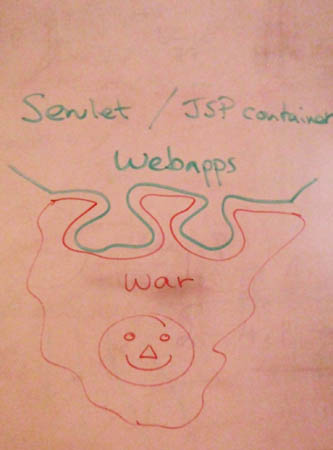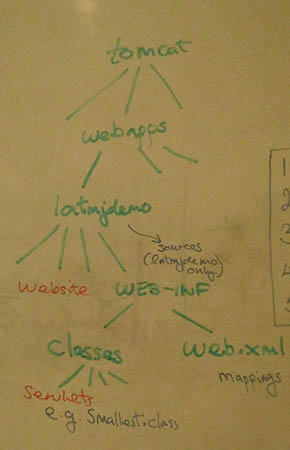
|
Training, Open Source Programming Languages |
| Home | Accessibility | Courses | The Mouth | Resources | Site Map | About Us | Contact |
| For 2023 (and 2024 ...) - we are now fully retired from IT training. We have made many, many friends over 25 years of teaching about Python, Tcl, Perl, PHP, Lua, Java, C and C++ - and MySQL, Linux and Solaris/SunOS too. Our training notes are now very much out of date, but due to upward compatability most of our examples remain operational and even relevant ad you are welcome to make us if them "as seen" and at your own risk. Lisa and I (Graham) now live in what was our training centre in Melksham - happy to meet with former delegates here - but do check ahead before coming round. We are far from inactive - rather, enjoying the times that we are retired but still healthy enough in mind and body to be active! I am also active in many other area and still look after a lot of web sites - you can find an index ((here)) |
|
What does a web application look like under Tomcat?  When you're deploying a Java application on your web server, you're likely to be using a container engine such as Tomcat ([learn about tomcat]). If you're not the author of the application, it will probably come to you in a file with a .war extension - a Web ARchive file. A .war file contains loads of other files, compressed, for distribution and in development mode your Tomcat server will unpack it automatically for you. The layout of the files with the .war should be such that it will attach to Tomcat like a jigsaw puzzle piece and just run. When you're deploying a Java application on your web server, you're likely to be using a container engine such as Tomcat ([learn about tomcat]). If you're not the author of the application, it will probably come to you in a file with a .war extension - a Web ARchive file. A .war file contains loads of other files, compressed, for distribution and in development mode your Tomcat server will unpack it automatically for you. The layout of the files with the .war should be such that it will attach to Tomcat like a jigsaw puzzle piece and just run. Once your .war in unpacked, you'll see a whole web application structure is revealed on the file system, as shown here. Within the application folder are your 'regular' web site files - your .html pages, and images, and so on - also style sheets and more. And there's a directory called WEB-INF which is not directly served, but which contains all the extra bits needed ... Once your .war in unpacked, you'll see a whole web application structure is revealed on the file system, as shown here. Within the application folder are your 'regular' web site files - your .html pages, and images, and so on - also style sheets and more. And there's a directory called WEB-INF which is not directly served, but which contains all the extra bits needed ...The web.xml file is the configuration data for your application - there's an application name, and details of which java classes may to which URLs to provide your servlets. The classes directory contains the classes that are servlets, and also other classes which are used within those servlets, or within Java Server Pages. With an application that you're not developing yourself, these classes will be in a compiled (.class) format and you won't be able to change the programming that they contain ... if you've got the source code, you can compile it up elsewhere and then replace those class files with two cautions - firstly, you'll need the servlet classes from Tomcat at compile time, and secondly please REMEMBER that Tomcat is a caching application container and if you change a class file you'll need to restart the web application for the modified file to be taken into account. If you're a regular reader here, you'll guess I was teaching Tomcat deployment yesterday. If you're not a 'regular', you might like to know that we run a regular Apache httpd and Tomcat deployment training course on which we welcome delegates from a wide variety of companies and other organizations ;-) (written 2010-02-20, updated 2010-03-03) Associated topics are indexed as below, or enter http://melksh.am/nnnn for individual articles J607 - Java - Servlets, JSP, Tomcat[1766] Diagrams to show you how - Tomcat, Java, PHP - (2008-08-22) [2058] Invoker and cgi servlets on Tomcat 6 - (2009-02-27) [2147] A very easy JSP (Java Server Page) - (2009-05-01)
Some other Articles
Compile but do not run PHP - syntax check onlyOptimising and caching your MySQL enquiries Counting rows in joined MySQL tables Relating tables with joins in MySQL What does a web application look like under Tomcat? Object Oriented Programming in PHP How is your tax pound spent? su or su - ... what is the difference? Finding what has changed - Linux / Unix Courses - Melksham and elsewhere - until the end of April |
4759 posts, page by page
Link to page ... 1, 2, 3, 4, 5, 6, 7, 8, 9, 10, 11, 12, 13, 14, 15, 16, 17, 18, 19, 20, 21, 22, 23, 24, 25, 26, 27, 28, 29, 30, 31, 32, 33, 34, 35, 36, 37, 38, 39, 40, 41, 42, 43, 44, 45, 46, 47, 48, 49, 50, 51, 52, 53, 54, 55, 56, 57, 58, 59, 60, 61, 62, 63, 64, 65, 66, 67, 68, 69, 70, 71, 72, 73, 74, 75, 76, 77, 78, 79, 80, 81, 82, 83, 84, 85, 86, 87, 88, 89, 90, 91, 92, 93, 94, 95, 96 at 50 posts per pageThis is a page archived from The Horse's Mouth at http://www.wellho.net/horse/ - the diary and writings of Graham Ellis. Every attempt was made to provide current information at the time the page was written, but things do move forward in our business - new software releases, price changes, new techniques. Please check back via our main site for current courses, prices, versions, etc - any mention of a price in "The Horse's Mouth" cannot be taken as an offer to supply at that price.
Link to Ezine home page (for reading).
Link to Blogging home page (to add comments).
PH: 01144 1225 708225 • EMAIL: info@wellho.net • WEB: http://www.wellho.net • SKYPE: wellho
PAGE: http://www.wellho.net/mouth/2642_Wha ... mcat-.html • PAGE BUILT: Sun Oct 11 16:07:41 2020 • BUILD SYSTEM: JelliaJamb